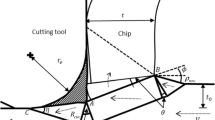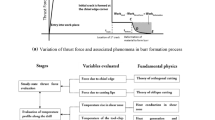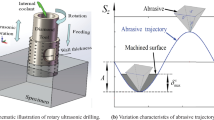Abstract
Exit burr formation in drilling of aluminum materials is a common problem in aircraft assembly operations. Burrs formed at the exit surface of the workpiece need to be removed, and the deburring is a non-value but time and costs waste operation, particularly in automatic drilling and riveting assembly. This paper presents an analytical model of the exit burr formation to predict the burr height and thickness, and drilling experiments was developed to verify the availability of the proposed model. The impacts of process parameters, such as cutting force, spindle rotational speed, feed rate, and temperature effect were taken into consideration. Drill geometrical factors such as point angle, helix angle, chisel edge, and web thickness were also used to improve the practicability of the model. The differences between calculated burr size and experimental result were discussed, and specific conclusions were presented.
Similar content being viewed by others
References
Pilny L, Chiffre LD, Piska M, Morten FV (2012) Hole quality and burr reduction in drilling aluminium sheets. CIRP Journal of Manufacturing Science and Technology 5(2):102–107
Aurich JC, Dornfeld D, Arrazola PJ, Franke V, Leitz L, Min S (2009) Burrs—analysis, control and removal. CIRP Annals-Manufacture Technology 58:519–542
Dornfeld D, Min S (2010) A review of burr formation in machining. Burrs-Analysis, Control and Removal, Springer, Berlin Heidelberg, pp 3–11
Choi J, Min S, Dornfeld DA, Alam M, Tzong T (2003) Modeling of inter-layer gap formation in drilling of a multi-layered material. In: Proc. 6th CIRP Workshop on Modeling of Machining, McMaster University, Hamilton, pp.36-41
Biermann D, Hartmann H (2012) Reduction of burr formation in drilling using cryogenic processing cooling. 45th CIRP conference on manufacturing system. Procetia CIRP 3:85–90
Bi S, Liang J (2011) Robotic drilling system for titanium structures. Int J Adv Manuf Technol 54:767–774
Liang J, Bi S (2010) Design and experimental study of an end effector for robotic drilling. Int J Adv Manuf Technol 50:399–407
Rivero A, Aramendi G, Herranz S, Lacalle LN (2006) An experimental investigation of the effect of coatings and cutting parameters on dry drilling performance of aluminium alloys. Int J Adv Manuf Technol 28:1–11
Ko SL, Lee JK (2001) Analysis of burr formation in drilling with a new-concept drill. J Mater Process Technol 113:392–398
Ko SL, Chang JE, Yang GE (2003) Burr minimizing scheme in drilling. J Mater Process Technol 140:237–242
Furness RJ, Wu CL, Ulsoy AG (1992) Statistical analysis of the effects of feed speed and wear on hole quality in drilling. Sensors and Signal Processing for Manufacturing PED-Vol 55:97–112
Pena B, Aramendi G, Rivero A, Lacalle LN (2005) Monitoring of drilling for burr detection using spindle torque. Int J Mach Tool Manuf 45:1614–1621
Kilickap E (2010) Modeling and optimization of burr height in drilling of Al-7075 using Taguchi method and response surface methodology. Int J Adv Manuf Technol 49:911–923
Cantero JL, Tardio MM, Canteli JA, Marcos M, Miguelez MH (2005) Dry drilling of alloy Ti–6Al–4V. Int J Mach Tool Manuf 45:1246–1255
Lauderbaugh LK (2009) Analysis of the effects of process parameters on exit burrs in drilling using a combined simulation and experimental approach. J Mater Process Technol 209(4):1909–1919
Nouari M, List G, Girot F, Coupard D (2003) Experimental analysis and optimization of tool wear in dry machining of aluminium alloys. Wear 255:1359–1368
Isbilir O, Ghassemieh E (2011) Finite element analysis of drilling of titanium alloy. Procedia Engineering 10:1877–1882
Sangkee M, Dornfeld DA, Kim J, Shyu B (2001) Finite element modeling of burr formation in metal cutting. Machining Science and Technology 5(3):307–322
Lauderbaugh LK (2003) A finite element model of exit burrs for drilling of metals. Finite Elements in Analysis and Design 40:139–158
Segonds S, Masounave J, Songmene V, Christian B (2013) A simple analytical model for burr type prediction in drilling of ductile materials. J Mater Process Technol 213:971–977
Kim J, Dornfeld DA (2002) Development of an analytical model for drilling burr formation in ductile materials. Transactions of the ASME, Journal of Manufacturing Science & Engineering 124:192–198
Kim J, Dornfeld DA (2000) Development of drilling burr control chart for stainless steel, transactions of NAMRI/SME XXVIII, pp:317-322
Lauderbaugh LK, Mauch CA (2001) An exit burr model for drilling of metals. J Manuf Sci Eng 123:562–566
ISO 13715.2000 Geometrical product specifications (GPS)-technical drawings-edges of undefined shape, vocabulary and indications, international organization for standardization, Geneva, Switzerland
Mauch C, Lauderbaugh LK (1990) Modeling the drilling process—an analytical model to predict thrust force and torque. Computer Modeling and Simulation of Manufacturing Processes B:59–66
Elhachimi M, Torbaty S, Joyot P (1999) Mechanical modeling of high speed drilling. 1: predicting torque and thrust. International Journal of Machine Tools & Manufacture 39:553–568
Elhachimi M, Torbaty S, Joyot P (1999) Mechanical modeling of high speed drilling. 2: predicted and experimental results. International Journal of Machine Tools & Manufacture 39:569–581
Kachanov LM (2004) Fundamentals of the theory of plasticity. Dover publications, New York, pp 245–248
Conway HD (1948) The bending of symmetrically loaded circular plates of variable thickness. ASME J Appl Mech 16:1–6
Shaw MC, Cook NH (1954) Metal cutting principles. Massachusetts Institute of, Technology, pp 3.1–3.15
Trigger KJ, Chao BT (1951) An analytical evaluation of metal cutting temperature. Trans ASME 73:57–68
Eckert ERG, Drake RM (1972) Analysis of heat and mass transfer. McGraw-Hill pp 174–176
Author information
Authors and Affiliations
Corresponding author
Ethics declarations
Funding
This work was supported by “the National Natural Science Foundation of China (NO.51575273),” “Aeronautical Science Foundation of China (Nos. 2013ZE52067 and 2014ZE52057),” “Funding of Jiangsu Innovation Program for Graduate Education (No. KYLX15_0294),” and “the Fundamental Research Funds for Central Universities (No. NS2015052).”
Rights and permissions
About this article
Cite this article
Bu, Y., Liao, W.H., Tian, W. et al. An analytical model for exit burrs in drilling of aluminum materials. Int J Adv Manuf Technol 85, 2783–2796 (2016). https://doi.org/10.1007/s00170-015-8125-8
Received:
Accepted:
Published:
Issue Date:
DOI: https://doi.org/10.1007/s00170-015-8125-8




